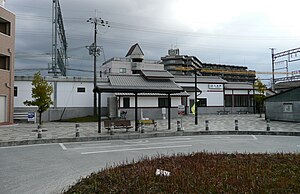| Kujō Station 九条駅 | ||||||||||||||||||
|---|---|---|---|---|---|---|---|---|---|---|---|---|---|---|---|---|---|---|
| Kintetsu Railway commuter rail station | ||||||||||||||||||
 The west entrance of Kintetsu Kōriyama Station—May 2007 The west entrance of Kintetsu Kōriyama Station—May 2007 | ||||||||||||||||||
| General information | ||||||||||||||||||
| Location | 375, Aza-deguchi, Kujochō, Yamatokōriyama-shi, Nara-ken 639-1001 Japan | |||||||||||||||||
| Coordinates | 34°39′34″N 135°46′59″E / 34.659432°N 135.782972°E / 34.659432; 135.782972 | |||||||||||||||||
| Owned by | ||||||||||||||||||
| Operated by | ||||||||||||||||||
| Line(s) | B Kashihara Line | |||||||||||||||||
| Distance | 4.0 km (2.5 miles) from Yamato-Saidaiji | |||||||||||||||||
| Platforms | 2 side platforms | |||||||||||||||||
| Tracks | 2 | |||||||||||||||||
| Train operators | ||||||||||||||||||
| Bus stands | 1 | |||||||||||||||||
| Connections | ||||||||||||||||||
| Construction | ||||||||||||||||||
| Structure type | At grade | |||||||||||||||||
| Parking | None | |||||||||||||||||
| Bicycle facilities | ||||||||||||||||||
| Accessible | Yes (2 elevators for the ticket gate, 2 elevators for the platforms, and 1 bathroom) | |||||||||||||||||
| Other information | ||||||||||||||||||
| Station code | B29 | |||||||||||||||||
| Website | www | |||||||||||||||||
| History | ||||||||||||||||||
| Opened | 1 April 1921 (1921-04-01) | |||||||||||||||||
| Rebuilt | 2002 | |||||||||||||||||
| Passengers | ||||||||||||||||||
| FY2020 | 2321 daily | |||||||||||||||||
| ||||||||||||||||||
| ||||||||||||||||||
Kujō Station (九条駅, Kujō eki) is a passenger railway station located in the city of Yamatokōriyama, Nara Prefecture, Japan. It is operated by the private transportation company, Kintetsu Railway.
Lines
Kujō Station is served by the Kashihara Line and is 4.0 kilometers from the starting point of the line at Yamato-Saidaiji and 38.6 kilometers from Kyoto.
Layout
The station is an above-ground station with two side platforms and two tracks. The effective length of the platform is for four cars. The ticket gates and concourse are underground, while the platform is above ground. There are two station entrances and ticket gates, one on the east side and one on the west side. There are two elevators. The station is unattended.</ref>
Platforms
| 1 | ■ Kashihara Line | for Yamato-Yagi and Kashihara-Jingumae |
| 2 | ■ Kashihara Line | for Yamato-Saidaiji and Kyoto |
History
Kujō Station was opened on April 1, 1921 on the Osaka Electric Tramway Unebi Line. On 15 March 1941, the line merged with the Sangu Express Railway and became the Kansai Express Railway, which was merged with the Nankai Electric Railway on 1 June 1944 to form Kintetsu.
Passenger statistics
In fiscal 2019, the station was used by an average of 2,321 passengers daily (boarding passengers only).
Surrounding area
- Kujo Sports Center
- Nara Prefectural Nara Special Needs School
See also
References
- Terada, Hirokazu (July 2002). データブック日本の私鉄 [Databook: Japan's Private Railways]. Japan: Neko Publishing. ISBN 4-87366-874-3.
- "九条駅" [Kujō Station]. hacchi-no-he.net. Retrieved 16 March 2018.
- Kintetsu Company History
- Nara Prefecture Statistical Yearbook
External links
 Media related to Kujo Station (Nara) at Wikimedia Commons
Media related to Kujo Station (Nara) at Wikimedia Commons- Official website (in English)
| Stations of the Kashihara Line | |
|---|---|
| Former route abandoned in 1939 | |
This Nara Prefecture railroad station-related article is a stub. You can help Misplaced Pages by expanding it. |

